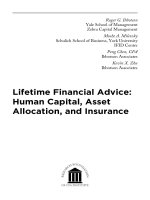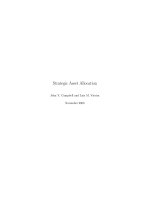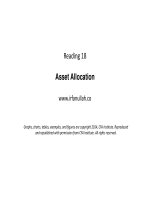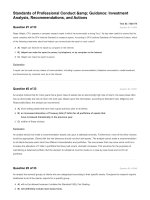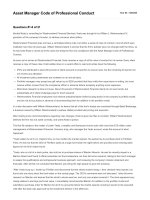Q a schweser self test 06 asset allocation answers
Bạn đang xem bản rút gọn của tài liệu. Xem và tải ngay bản đầy đủ của tài liệu tại đây (281.39 KB, 5 trang )
Question #1 of 13
A) 5.08% for Carlson and 6.72% for Olsen.
Explanation
Portfolio 1 has an expected return of 6.5% and an expected standard deviation of 5.95%. Given
Carlson's risk aversion score of 8, his utility-adjusted return would be:
UP = 6.5% - 0.005(8)(5.952) = 5.08%
Portfolio 4 has an expected return of 8.75% and an expected standard deviation of 14.25%.
Given Olsen's risk aversion score of 2, his utility-adjusted return would be:
UP = 8.75% - 0.005(2)(14.252) = 6.72%
Question #2 of 13
C) No, because a set of asset classes should cover a majority of all possible investable assets.
Explanation
Asset classes have been appropriately specified if:
Assets in the class are similar from a descriptive as well as a statistical perspective.
They are not highly correlated so they provide the desired diversification.
Individual assets cannot be classified into more than one class.
They cover the majority of all possible investable assets.
They contain a sufficiently large percentage of liquid assets.
Robinson was incorrect to not include a majority of all possible investable assets in a given
portfolio analysis. This was evident in his choice to not consider an international asset class
during his development of client portfolios.
Question #3 of 13
B) Mean-variance optimization.
Explanation
The analysis used expected return and standard deviation of asset classes to produce required
portfolio asset allocations. That is what MVO does.
Question #4 of 13
C) 9.24%.
Explanation
An expected return of 7.5% lies between Portfolios 2 and 3, with expected returns of 7.25% and
8%, respectively. First, determine the weight that should be invested in these two portfolios to
achieve the expected return.
7.5% = w2 × 7.25% + (1 - w2) × 8%
w2 = 67%, therefore w3 = 33%
The standard deviation of the portfolio is the weighted average of the standard deviations of
Portfolios 2 and 3.
σP = (0.67)(0.083) + (0.33)(0.1115) = 9.24%
Note that it appears Robinson is using corner portfolio concepts even though he has not properly
selected corner portfolios. In addition to considering only a small set of asset classes, he has not
properly identified the CPs as the minimum variance portfolio and portfolios with the + to 0 or 0 to
+ asset class weight change. This is curious, but because it is not asked about, solve the
questions asked.
Question #5 of 13
C) The risk-free asset would be -25% and the tangency portfolio would be 125%.
Explanation
With no constraint against borrowing the expected return is the weighted average of the risk-free
asset and the tangency portfolio. The tangency portfolio is the portfolio with the highest Sharpe
ratio which happens to be Portfolio 1. The expected return of Portfolio 1 is 6.5%. The weights in
the risk-free asset and the tangency portfolio are as follows:
7.5% = wRF × 2.5% + (1 - wRF) × 6.5%
wRF = -25%, therefore wT = 125%
In order to achieve the desired expected return of 7.5% with no constraint against leverage, 25%
should be borrowed at the risk-free rate and 125% should be invested in the tangency portfolio.
Question #6 of 13
A) Point A.
Explanation
Statement A is least correct because the CML concept of combining the market portfolio and the
risk-free asset is not relevant to most clients. For an ongoing portfolio there is no true risk-free
asset with a known return along with zero standard deviation and zero correlation to other
assets. Most clients are concerned with ongoing and multiple time periods. In addition, few
clients will accept a long-term strategic allocation to the risk- free asset or borrowing (leverage).
The rest of the statement is true but not the premise that the CML is relevant to most clients'
SAA.
Point B is true as most individuals, foundations, and endowments do not have the specifically
measurable, dateable liabilities to support the ALM approach. In contrast, ALM is the appropriate
approach for defined benefit, insurance companies, and banks.
Point C is also true. Both methods are variations and extensions on basic mean-variance
mathematics. Constrained Black-Litterman solves for market consensus expected return by
asset class. The manager can then view and selectively adjust these expected returns. The view
adjusted returns are then generally re-input into mean-variance analysis to solve for the efficient
frontier. The Resampled Efficient Frontier overcomes the instability of the basic mean-variance
model by running multiple passes of the model with slight variations of the inputs, then an
average of possible asset allocations for various points on the EF are generated. These average
asset allocations are more stable in that their makeup is less likely to change and less portfolio
rebalancing will be required over time for minor changes in market conditions.
Question #7 of 13
B) 16.4%.
Explanation
The return on the unhedged portfolio in dollars factors in the beginning and ending spot rates:
The portfolio return in dollars = (€ 320,000 × $1.20/€ ) - (€ 300,000 × $1.10/€ ) / (€ 300,000 ×
$1.10/€ ) = ($384,000 - $330,000) / $330,000 = 16.4%.
Both the investment in euro terms and the euro itself increased in value. The investor benefited
from both.
Question #8 of 13
C) 9.1%.
Explanation
In a simple hedge of the principal, the manager would hedge the € 300,000 principal. The
manager shorts the euro to hedge the long euro position in the European stock. The loss on the
futures contracts in dollars = € 300,000 × ($1.15/€ - $1.23/€ ) = -$24,000.
The profit on the unhedged portfolio in dollars is: (€ 320,000 × $1.20/€ ) - (€ 300,000 × $1.10/€ ) =
$384,000 - $330,000 = $54,000.
In net, the investor has made a dollar return of (-$24,000 + $54,000) / $330,000 = 9.1%.
Question #9 of 13
B) incorrect because a currency depreciation would be accompanied by an increase in sales.
Explanation
Freer is incorrect because currency depreciation is normally accompanied by an increase in
sales, as the weaker currency value would make the goods cheaper to foreign importers. The
minimum-variance hedge ratio is derived by regressing the unhedged return on the foreign stock
in dollar terms against the return on the currency futures contract.
Question #10 of 13
B) incorrect regarding the short run.
Explanation
McLaughlin is basically discussing how interest rates are related to the forward exchange rate
and issues related to roll return. Her comments about the short run are incorrect. IRP determines
the relationship of spot and forward exchange rates. The currency with the higher interest rate
will trade at a forward discount, so she is correct to reason that all else the same, an increase in
the country's interest rate would produce a downward movement of the forward exchange rate.
But a decline in the forward price is a gain for the short position, a positive and not a negative for
holding period return. Regarding the long run, she is correct; if held to contract expiration, the roll
return is known in advance and uncertainty (basis risk) is reduced. The forward exchange rate is
locked in as the ending exchange rate.
Question #11 of 13
C) buy 64 put option contracts and sell 64 call option contracts.
Explanation
Freer is certain the CHF will decline so selling the CHF forward is the simplest strategy. An
alternative to selling the CHF forward is the sell ATM calls on the CHF and buy ATM puts on the
CHF. This will remove both upside and downside to the CHF. This can be referred to is various
topic areas as a forward conversion with options or a collar with ATM options. Buying the put
alone will provide downside protection but will cost more and is not appropriate as an alternative
to forward sale when there is high confidence the CHF will decline. The correct size for the
contract positions is 4,000,000/62,500 = 64 contracts.
Question #12 of 13
C) correct.
Explanation
Freer is correct. In a strategic hedge ratio approach, the manager is allowed discretion for
hedging currency risk within the guidelines of the investor's investment policy statement. This
approach is best because it manages currency risk as an integral part of the portfolio. It allows
the manager to view the interaction between the risk of the asset and the currency. The currency
overlay approach would assign the currency hedging process to another manager when the
portfolio manager does not have the necessary hedging expertise. The overall process is still
managed with the guidelines established by the investment policy statement. The currency as a
separate asset allocation approach manages currency risk separate from the rest of the portfolio.
Question #13 of 13
Explanation
The market cap-weighted index will have lower turnover and transaction costs with no need to
rebalance. In contrast the equal-weighted will need frequent sales of the outperformers and
purchases of underperformers to maintain equal weight. This will increase turnover and costs.
